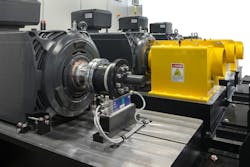ACS builds successful dynamometer for eVTOL manufacturer
System integrator and testing equipment provider ACS provided testing equipment to electric vertical take-off and landing (eVTOL) aircraft manufacturer, using Siemens drives and induction motors. The four-axis test dynamometer from ACS will ensure safe operations and aircraft performance.
These aircraft use multiple battery-powered rotors to hover, take-off and land vertically. In fact, their aeronautical operating principles are not unlike those of commercial and hobby drones. Typically, eVTOL aircraft have short-hop ranges of under 100 miles and cruising speeds between 100–200 miles per hour. They are designed to safely conduct military and civilian applications ranging from passenger transport to medical evacuation operations.
Because the safety of eVTOL aircraft requires extremely reliable performance of its electric motors, testing them under simulated flight loads and beyond are critical. The industry’s need for precise, efficient and cost-effective dynamometer testing systems has been an opportunity for ACS, a CE- and UL 508 A-certified Siemens solution partner.
According to ACS Director of Facility Planning and Integration Matt Thiel, the company was approached by one of the eVTOL industry’s most promising aircraft manufacturers to design, engineer and build a four-axis dynamometer testing system. The customer also needed it ready for commissioning and deployment in just a few months to meet a tight market introduction schedule and the rigorous expectations of investors.
Thiel says: “Because their prototype aircraft’s rotors will be powered by four large, battery-operated electric motors, they need to test each motor’s output to ensure it delivers the correct speed and torque. They also must test each motor’s endurance and response time, in addition to a long list of other variables.
“So, to do that, they’ll connect our system to each motor to be used on one of their aircraft to simulate a rotor’s aerodynamic loading and ensure they perform as expected, including the operation of their safety control functions. The dynamometer system is designed to match the speed and the load as calculated or measured in actual take-offs, landings and flight paths.”
Thiel explains that the ACS dynamometer is part of the eVTOL maker's component development, testing and systems integration laboratory. He notes that ACS has designed and constructed numerous similar integrated facilities, including many with chambers capable of simulating climate and altitude conditions. However, for this customer, the focus was on the dynamometer system, its installation, and its commissioning.
“For testing their propulsion systems using our dynamometer, their engineers will assemble the complete propulsion, power, and control system for their aircraft, as it would be in an operating eVTOL, with the motors, their controllers, the correct wire lengths and all other critical components,” Thiel says. “In the aerospace industry they call this setup an ‘iron bird,’ and it is used to validate the vehicle with all the hardware and controls in the loop.”
Four-axis, 1,205 hp (900 kW) AC regenerative drive system
To simulate flight loads on the eVTOL’s four electric motors, ACS built a four-axis, 1,205 hp (900 kW) AC regenerative drive system (Figure 1) with 480-volt, 1,200-amp, 3-phase power. The drive system powered four 335 hp (250 kW) motors, each one coupled to a propeller drive motor destined for use in the customer’s eVTOL aircraft. Each dynamometer motor rests on a riser that contains all the connections necessary to run the system and precisely test the corresponding drive motor’s performance characteristics. The customer provided the aircraft controller and data acquisition system for the testing, and ACS integrated its dynamometer controller functionality within their software platform to allow for seamless operation.
The regenerative design enables the energy captured from each dynamometer motor absorbing load to be used to operate the motors in the system that may be outputting power during the test or to be fed back to the facility grid, offsetting other power consumption in the building.
This approach offers two benefits. First, it can diminish the size and cost of power electronics needed for connecting to the grid or decrease the energy storage capacity of a battery power source. Second, it eliminates the need for a load-bank system to dissipate the energy produced by the dynamometer as waste heat.
To further de-risk the project’s strict timeline, ACS used Siemens SINAMICS S120 drives and asynchronous SIMOTICS M-1PH8 induction motors (Figure 2). As a Siemens solution partner, the company’s engineers were familiar with these product families. “This Siemens drive system is high-performance and extremely versatile, enabling the precise control of our customers’ subject electric motors,” says Thiel, noting that a Siemens SIMATIC S7-1500 PLC provides a communication gateway between the SINAMICS drives and the host controller for robust dynamometer operation.
He adds: “Also, the out-of-the-box, plug-and-play integration of Siemens drives and motors ensured their interoperability, so our engineers could focus their time on critical system design tasks rather than getting the components to work together. Plus, the Siemens components’ adherence to standardized industrial communications protocols made connecting them with the customer-provided SCADA system a straightforward task.”

